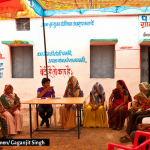
The Progress Made in Rural Citizens Participation in Governance
16 October 2020
Across the country, a curious pattern emerges when one looks at how legal and process reforms have progressed, with respect to institutionalising the participation of urban citizens in governance. The picture becomes even more paradoxical when one compares the progress made in rural decentralised governance with urban governance.
There is no doubt that urban systems for participation are weak, from their very design as envisaged in the Constitution. While the 73rd amendment defines the Gram Sabha as a body of all voters in a village, there is no equivalent institution defined in the 74th amendment, for urban citizens. What is mandated are Wards Committee – note the plural in ‘Wards’ – it means that a Wards Committee can be constituted for many wards.
Furthermore, the actual design of the Wards Committees are left to the states to determine, and there is no compulsion that they must necessarily provide participative opportunities to all voters. To weaken matters further, Wards Committees are mandated only for those urban local governments with a population of more than 3 lakhs. Therefore, if a village is converted into a Town Panchayat, there is no participative system at all, till that urban body becomes a city with a population more than 3 lakh people.
Of course, the weak constitutional mandate for urban participation need not be a constraint to any state that truly believes in strengthening people’s participation in governance. There are no bars in the Constitution for creating intensely participative structures; all that it lays down are certain minimum requirements, which, as I have described earlier, are much weaker for urban local governments as compared to rural ones.
The case of Karnataka provides an example of the contrasting approaches adopted for rural and urban participation. Karnataka is generally regarded as being one of the champions, at least in a comparative sense, of Panchayati Raj. It underwent a big bang decentralisation of sorts by setting up and empowering Zilla Parishads and Mandal Panchayats in 1987.
What was noteworthy at that time was the carving out of 24 per cent of the development budget for the Panchayats, and the reservation of 25 per cent of the seats for women, in the Panchayats. Both of these reforms pre-dated the 73rd amendment. In 1994, following the 73rd amendment, Karnataka superseded its earlier law and passed a fresh Panchayat Raj Act. The provisions related to the Gram Sabha from the earlier act were retained in the new one, and they were empowered to ‘assist’ the Gram Panchayat, as also ‘identify’ beneficiaries. There was nothing remarkable about these provisions; they more or less reflected the same approach taken by most other states.
However, in 2002, following a court judgment that interpreted the Gram Sabha provision in the law rather narrowly, holding that ‘identification’ of beneficiaries does not extend to ‘selection’, it was decided to strengthen the provisions of the law and clarify in greater detail the powers and duties of Gram Sabhas.
What followed were a series of far-reaching amendments that were approved by the government in 2003. In order to enhance the quality of people’s participation through greater empowerment of the Gram Sabha, a two-tier system comprising Ward Sabhas for each constituency in the Gram Panchayat and Gram Sabhas at the Panchayat level, were established. The frequency of their meetings was increased. Nineteen important functions were identified for the Gram and Ward Sabhas, which included approval of the annual plan, generating proposals and determining priority of schemes, identifying beneficiaries, recognising deficiencies in water supply and streetlight arrangements, and promoting adult education.
If a village is converted into a Town Panchayat, there is no participative system at all, till that urban body becomes a city with a population more than 3 lakh people.
New social audit rules were issued to ensure the effective participation of the Gram Sabhas in them. Most importantly, it was mandated that Gram Sabhas would not only identify beneficiaries for all schemes but also arrange beneficiary lists in order of priority. Once this is done, the law prohibited any higher levels from interfering with the beneficiary list. In order to decentralise planning, Gram Sabhas were tasked with generating proposals and determining the priority of all schemes and development programmes to be implemented in the Panchayat area, even by higher agencies such as the Zilla Panchayat and the Taluk Panchayat.
In 2016, following more than a decade’s experience with the earlier amendment, further amendments were made in the law to strengthen the institutions of the Gram and Ward Sabhas. An important one was that both institutions now had the right to demand for knowing how much the budget that is allocated for expenditure in their respective areas was, not only from the Gram Panchayat but also from all departments that expend resources in their areas.
This amendment is beginning to have the effect of putting pressure on departments to break down their allocations to Gram Panchayat-sized bits wherever possible, and make that information available to the Gram Sabhas. It helps that the Panchayat members are also more aware of their rights, and they are using these provisions to demand such information from departments.
What about the urban situation in Karnataka? There lies the stark contrast. More on that in my next blog.
T.R. Raghunandan is an Advisor at the Accountability Initiative.





